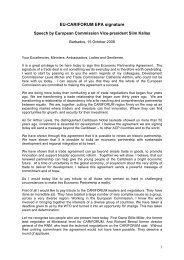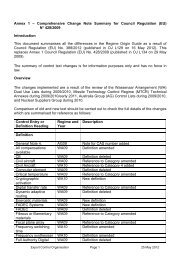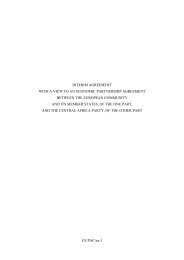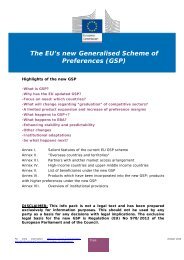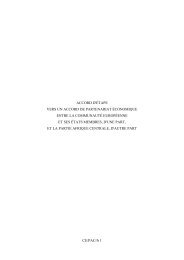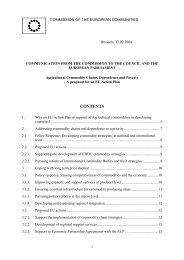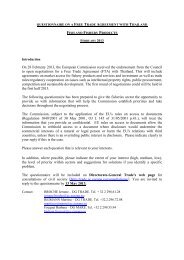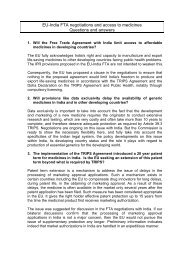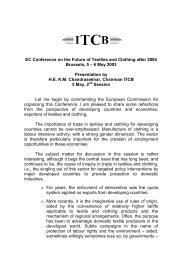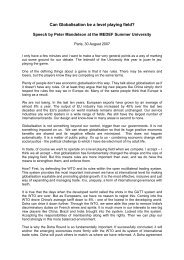Report on the Implementation of the derogation to ... - Trade Websites
Report on the Implementation of the derogation to ... - Trade Websites
Report on the Implementation of the derogation to ... - Trade Websites
You also want an ePaper? Increase the reach of your titles
YUMPU automatically turns print PDFs into web optimized ePapers that Google loves.
Final <str<strong>on</strong>g>Report</str<strong>on</strong>g><br />
RoO Derogati<strong>on</strong> under <strong>the</strong> PACP-IEPA<br />
The primary motivati<strong>on</strong> behind PNG Government trying <strong>to</strong> establish an ‘ec<strong>on</strong>omic cluster’ or special<br />
ec<strong>on</strong>omic z<strong>on</strong>e in Madang (PMIA) is <strong>to</strong> achieve greater ec<strong>on</strong>omies <strong>of</strong> scale. Similarly, as new<br />
processing developments are c<strong>on</strong>structed and commence operati<strong>on</strong>s in Malahang, Lae, <strong>the</strong>y will also<br />
benefit from <strong>the</strong> same. The tuna processing industry may derive positive externalities from<br />
improvements in areas such as freight, telecommunicati<strong>on</strong>s etc. through developments realised in<br />
o<strong>the</strong>r export-orientated industries in PNG (e.g. new liquid natural gas (LNG) project).<br />
However, <strong>the</strong> chances <strong>of</strong> PNG becoming a ‘tuna processing hub’ <strong>of</strong> comparable magnitude <strong>to</strong><br />
Thailand remains very unlikely in <strong>the</strong> short-medium term. Currently, Thailand processes over<br />
700,000 mt/year and has a daily maximum processing capacity <strong>of</strong> 3,000 mt/day (current producti<strong>on</strong><br />
~ 2,500 mt/day). 54 In comparis<strong>on</strong>, PNG currently processes around 70,000 mt (280 mt/day). If PNG<br />
were <strong>to</strong> realise its goal <strong>of</strong> processing over 1,000 mt/day, <strong>the</strong> canned tuna processing industry would<br />
grow <strong>to</strong> be comparable in size with <strong>the</strong> Philippines’ industry. 55<br />
A number <strong>of</strong> fac<strong>to</strong>rs (some <strong>of</strong> which PNG lacks) underpinned Thailand’s development as <strong>the</strong> world’s<br />
leading producer <strong>of</strong> canned tuna – a large export orientated-ec<strong>on</strong>omy; an already well-established<br />
food processing industry with supporting industries (e.g. can making, packaging) <strong>to</strong> help build<br />
ec<strong>on</strong>omies <strong>of</strong> scale; excellent shipping logistics; a highly productive labour force; strategically<br />
located <strong>to</strong> source raw materials from <strong>the</strong> Pacific and Indian Oceans <strong>to</strong> ensure c<strong>on</strong>tinuing <strong>of</strong> supply;<br />
financing available for raw material purchases/processing activities; strategic ‘co-packing’<br />
relati<strong>on</strong>ships with key US and EU firms; a ‘pro-business’ Government; and diversified producti<strong>on</strong><br />
bases (i.e. o<strong>the</strong>r seafood processing lines in additi<strong>on</strong> <strong>to</strong> tuna). 56<br />
3.3 PNG Tuna <strong>Trade</strong><br />
3.3.1 Exports 57<br />
Total Exports<br />
Total PNG tuna exports (for all gear types) fluctuated between 65,000-74,000 mt annually from<br />
2006-2010 (Table 3.9). Exports <strong>of</strong> frozen tuna, <strong>the</strong> majority <strong>of</strong> which is whole round frozen tuna, is<br />
<strong>the</strong> largest export category, and accounted for around 50% <strong>of</strong> <strong>to</strong>tal exports in 2010 (~32,000 mt). 58<br />
This fish is destined for processing in plants elsewhere, notably Thailand and <strong>the</strong> Philippines.<br />
Canned tuna and cooked loins (HS 1604 products) have collectively accounted for around 30-43% <strong>of</strong><br />
<strong>to</strong>tal exports. Over <strong>the</strong> past five years, cooked loin exports have c<strong>on</strong>sistently ranged between<br />
10,000-12,000 mt. Canned tuna exports have ranged between 12,000-17,000 mt, with no firm<br />
trends.<br />
The EU and <strong>the</strong> US are PNG’s largest export markets for canned tuna and cooked loins (HS 1604),<br />
<strong>to</strong>ge<strong>the</strong>r accounting for 80% <strong>of</strong> <strong>to</strong>tal exports.<br />
54 Hamilt<strong>on</strong> et al. 2011.<br />
55 Pokajam 2011.<br />
56 Hamilt<strong>on</strong> et al. 2011.<br />
57 Market sales volumes reflect finished product weights.<br />
58 This does not include fish transhipped in PNG ports by large chartered and foreign vessels, with <strong>the</strong> former amounting <strong>to</strong><br />
around 50,000 mt in most recent years.<br />
Linpico s.a.r.l. Page 41




